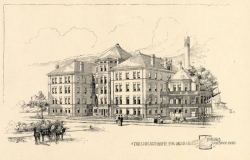Chicago Home for Incurables
| Chicago Home for Incurables | |
|---|---|
 | |
| Opened | 1898 |
| Closed | 1959 |
| Current Status | Preserved |
| Building Style | Single Building |
| Location | Chicago, IL |
| Alternate Names |
|
History[edit]
Established in 1886, the Chicago Home for Incurables has a long and storied past, which began with a $625,000 bequest from Chicago philanthropist Clarissa C. Peck. At the time, it was the largest philanthropic donation ever made by a woman in the US. In 1898, the Home was built at 56th Street and Ellis Avenue—the location of the Young Memorial Building today—to care for individuals in Cook County with conditions that were then deemed "incurable," including tuberculosis, rheumatism, paralysis, and locomotor ataxia (known today as tabes dorsalis). The Home accommodated 125 patients, who had access to lawns with shade trees and swinging hammocks, reading rooms, and a parlor on every floor. Patients were provided with wheelchairs, and male patients could go to a smoking room to "indulge to their hearts' content in the use of their favorite brands."
The Chicago Home for Incurables included a 68-bed ward dedicated to caring for patients with advanced cases of tuberculosis (TB), an infectious disease that typically affects the lungs but can attack any part of the body. Occupying the south wing of the home, the TB ward was established by Otto Young. In the 1920s, University of Chicago researcher Alexander A. Maximow, MD, provided a new understanding of TB when he reproduced the disease in lung tissue isolated from rabbits and traced its progression under the microscope. However, it wasn’t until the 1944 discovery of streptomycin—an antibiotic used to treat bacterial infections—that a cure for TB became a reality. Subsequently, sanatoriums became obsolete, as patients with the disease no longer required multiyear periods of hospitalization.
Since the Chicago Home for Incurables was founded, society has benefited from significant advances in science, medicine, public health, and sanitation. From the time the Home was established until its closing in the late 1950s, the average life expectancy in the US rose from 47 to 67 years. The University of Chicago acquired the Chicago Home for the Incurables in 1963 and changed the name to the "Young Memorial Building". Since then, It has functioned as departmental space for the university's architect, security, housing, and administrative facilities. Currently it houses the administrative offices of Court Theatre, the Smart Museum, and campus security.